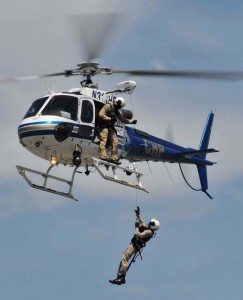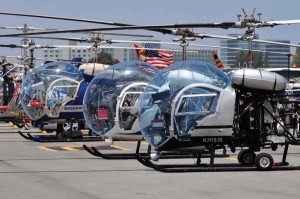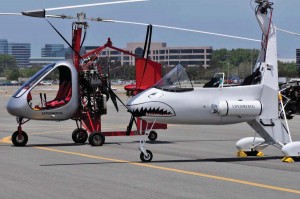By Hayman Tam
The annual Vertical Challenge helicopter air show, hosted by the Hiller Aviation Museum at San Carlos Airport in California, reached a milestone this June with the 10th annual event. More than 6,000 people attended and enjoyed a weekend of postcard-clear skies, spring temperatures and a firm breeze.

The Zeppelin NT normally cruises at 35 mph at 1,200 feet altitude and provides tours of the California coast
Vertical Challenge is a three-day event that traditionally starts on Friday evening with an event called “Wild Brew Yonder,” combining local microbreweries, good food and a twilight air show. Saturday brings the full air show, headlined this year by the Red Bull aerobatic helicopter team. The crowd also enjoyed an appearance by the Zeppelin NT. Military Day (on Sunday) gives attendees the chance to see military helicopters up close before they depart. All the civilian aircraft fly out the day before.
This event vies for the title of largest helicopter air show in the country. Helicopters from near and far come to be part of the atmosphere, with homebuilts, classics and gyroplanes seen on exhibit at this year’s event. Corporate sponsor Bell Helicopter had a chalet set up near the flight line for its guests in a spot nicknamed “Bellville.”
As they landed, the helicopters were collected into obvious groupings such as law enforcement, television and radio broadcast choppers and those in medical services (some flown in from Stanford University). Calstar and REACH were also in attendance.

The Hiller HJ-1 Hornet prototype (with ramjets in the rotor tips) first flew in 1950. This rare heli was on display at the air show.
Larger agencies, like the California Highway Patrol and Cal Fire, brought their helicopters to the party and also participated in the performance schedule with various demonstrations. Cal Fire had one of its big Hueys, which performed the always-popular water drop demonstration twice on Saturday.
New for 2009 was the naming of a Grand Marshall for the event. Yul Kwon, the 2006 winner of “Survivor: Cook Island,” was set to fly in via zeppelin and be dropped at show center. The winds, gusting up to 30 mph, thwarted multiple attempts by the Airship Ventures pilot to keep the giant dirigible lined up on the runway centerline. Upon final approach, the winds forced them to abandon landing and any further attempts. Although the crowd enjoyed seeing the zeppelin’s maneuverability and size so close to the ground, Kwon only got within 100 feet above the show over which he was going to preside.
Manufactured by the same zeppelin company as the famous Hindenburg, the 230-ft.-long Zeppelin NT (from New Technology) utilizes an aluminum and carbon fiber structure and helium gas for buoyancy. These airships have fly-by-wire controls and are powered by three 200-hp Textron Lycoming engines with swivel and gimballing abilities.
The Eureka is the first zeppelin to operate in the U.S. since the 1930s and is based at nearby Moffett Federal Airfield.

The California Highway Patrol helicopters are used in search and rescue missions, medical transport and crimes in progress.
The other star of the show was the Red Bull helicopter, the German BO-105 that’s been specially modified for aerobatic maneuvers and is flown by Chuck Aaron. He is the only helicopter pilot certified by the FAA to fly aerobatics in the U.S. Watching the helicopter perform loops and rolls was breathtaking proof of Aaron’s piloting skills. Other performers included the Red Bull Air Force skydiving team, Dan Buchanan’s hang glider performance, a gyroplane demonstration and the Bay Area Sundowners formation kite flying team.
Some aircraft were rare, like the tiny American Autogyro Sparrowhawk homebuilt flown in from Livermore. Then there was the Givens Predator that looked like it should be in a James Bond movie. Both of these aircraft get their forward thrust from a pusher prop while the free-turning overhead rotor provides lift, aptly demonstrated by the Predator in the afternoon portion of the show.
Two vintage UH-1 Hueys flew in along with several bubble-nosed Bell Model 47s — they were probably the oldest aircraft present. Camera Copters brought its Hughes 500D, complete with custom trailer and crew.
Military helicopters dominated the static display ramp. The Marines at Camp Pendleton sent several mean-looking Super Cobras and Hueys to the event. The U.S. Army provided a California-based CH-47D Chinook, and a MH-60R Seahawk from North Island NAS in San Diego came to represent the U.S. Navy.
Helicopter rides were offered at $50 each, and enthusiasts formed long lines most of the day for their chance.
This year also marked the 11th anniversary of the Hiller Aviation Museum. Located at San Carlos Airport (SQL), the museum was established by the late Stanley Hiller to showcase both Bay Area aviation and the accomplishments of the helicopter company bearing his name. He gained early fame by designing and building the first helicopter to fly on the West Coast, the XH-44 Hiller-Copter.
The museum’s collection includes his prototypes for jet tip rotorcraft, his one-man Flying Platform and a model of a Hiller design intended to catch a Saturn rocket first-stage as it floated down on giant parachutes! The museum is also home to some one-of-a kind exhibits, such as the forward fuselage of the long-cancelled Boeing Supersonic Transport.
San Carlos Airport is located approximately 10 miles south of San Francisco Airport. Constructed in 1948, the airport is home to about 500 aircraft and more than 30 aviation-related businesses.

The Bell Model 47 became the first helicopter certified for civilian use in 1946, with over 5,600 built.












